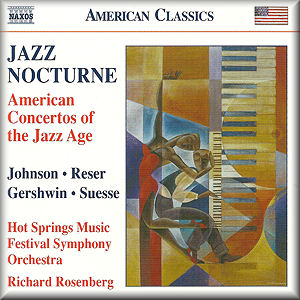1. Yamekraw, A Negro Rhapsody by James P. Johnson
2-4. Suite for Banjo and Orchestra by Harry Reser
5. Rhapsody in Blue by George Gershwin
6. Jazz Nocturne by Dana Suesse
7-9. Concerto in Three Rhythms by Dana Suesse
Hot Springs Music Festival Symphony Orchestra, conducted by Richard Rosenberg
Creole Serenaders (track 5)
Gary Hammond - Piano (track 1)
Don Vappie - Banjo (tracks 2-5)
Tatiana Roitman - Piano (track 5)
Peter Minton - Piano (track 6)
Michael Gurt - Piano (tracks 7-9)
One may be tempted to think of George Gershwin's Rhapsody in
Blue as a "one-off": an isolated attempt to fuse the
jazz idiom with the symphony orchestra. Of course, it wasn't all that
rare, as Gershwin also wrote his Concerto in F, Cuban Overture,
An American in Paris and the Second Rhapsody, all of which
blended jazz and the classics to some degree.
This album reveals that other composers were pursuing the same path as Gershwin in the twenties and thirties, although they all seem to be following in the footsteps of Rhapsody in Blue. There was a similar movement in what might be called "Symphonic Jazz" with the Third Stream which arose in the 1950s, but this was hardly ever successful, as it attempted to fuse two differing genres too closely. The experiments included on this album were happier, because they simply added jazz rhythms (especially syncopation) to classical music in a way that "serious" composers like Ravel and Milhaud also tried. In fact, Gershwin's Rhapsody in Blue and his piano concerto contain many anticipations of Ravel's two piano concertos.
The CD begins with James P. Johnson's Yamekraw, subtitled "A Negro Rhapsody". Johnson is best known as one of the founding fathers of the art of stride piano, in which the left hand supplies a two-beat rhythm for the right hand's melodies and often decorative improvisation. Yamekraw was premiered with Fats Waller (another exponent of stride) as the piano soloist in 1927 (the sleeve-note says 1928). Like the Rhapsody, it includes syncopated passages alongside romantic themes. Yamekraw is the name of "a Negro settlement situated on the outskirts of Savannah, Georgia". Like Gershwin's Rhapsody, the piece makes good use of prominent clarinets and outspoken trumpets. And it follows Gershwin in that some sections might well be mistaken for the piano concertos of Rachmaninov, who probably influenced Gershwin considerably. Like the other works on this CD, it was orchestrated by someone other than the composer - in this case, William Grant Still. One wonders how much influence the orchestrators had on the original ideas.
Probably the most astonishing item on this album is the Suite for Banjo and Orchestra, arranged by banjoist Don Vappie from pieces by Harry Reser. The banjo is often scorned, even by jazz musicians (e.g. "a gentleman is someone who owns a banjo but doesn't play it"), but it is here displayed as a virtuosic instrument capable of carrying the solo part in three concerto-like movements. Harry Reser himself played the banjo and led various bands as well as doing studio work from the 1920s onwards. The three pieces in the suite start with Heebie Jeebies, which is not the better-known popular song but a fast number with eerily ghostly changes. Then comes Flapperette, a slower but breezy piece, followed by Pickin's, which starts by bending notes almost in Japanese vein but soon picks up into a bright melody exhibiting the soloist's dexterity.
Rhapsody in Blue is so familiar that it doesn't need describing, although this version is taken from the original manuscript which Gershwin's brother Ira gave to Richard Rosenberg in 1978 and which contains some extra passages. This is the first recording of the unabridged version and it is performed very well, although it lacks some of the period charm of Gershwin's original recording with Paul Whiteman. Its opening clarinet glissando still has the power to surprise and, hearing the rhapsody for the umpteenth time, one is still struck by Gershwin's melodic prodigality. Tatiana Roitman handles the solo part with aplomb. Here and throughout the album, the recording quality is commendably clear and well balanced.
The last two works are by American composer Dana Suesse. She is not exactly a household name nowadays but she was famous in her day for composing popular songs as well as more extended pieces. She was nicknamed "The Girl Gershwin" and had a hand in such popular songs as You Ought To be In Pictures and The Night Is Young And You Are So Beautiful. Her melodic gift is evident in Jazz Rhapsody, whose second theme was translated into the song My Silent Love, which was recorded by Bing Crosby and many others (I can recommend Erroll Garner's flowery version on YouTube). It is certainly a very memorable tune and is played with lush romanticism by the orchestra.
Suesse's Concerto in Three Rhythms was premiered in 1932 at a Carnegie Hall concert which also included Gershwin's Second Rhapsody and the Grand Canyon Suite by Ferde Grof‚ (who arranged Dana's concerto as well as Rhapsody in Blue). The three rhythms in the Suesse concerto are the foxtrot, the blues and ragtime. The first movement is bouncy and assertive; the second slow and mournful - reminiscent in parts of Ravel's G major Piano Concerto; and the finale frolics merrily.
These pieces were recorded at the Hot Springs Music Festival in Arkansas at various times between 2005 and 2009. By making these recordings available together, Naxos has done us a service by making us more aware of a musical movement in the twenties and thirties which managed to put together two apparently different musical genres, without demeaning either of them. As Dana Suesse said: "There's certainly no harm in writing [music] in such a form that large numbers of people can enjoy it".
Tony Augarde
